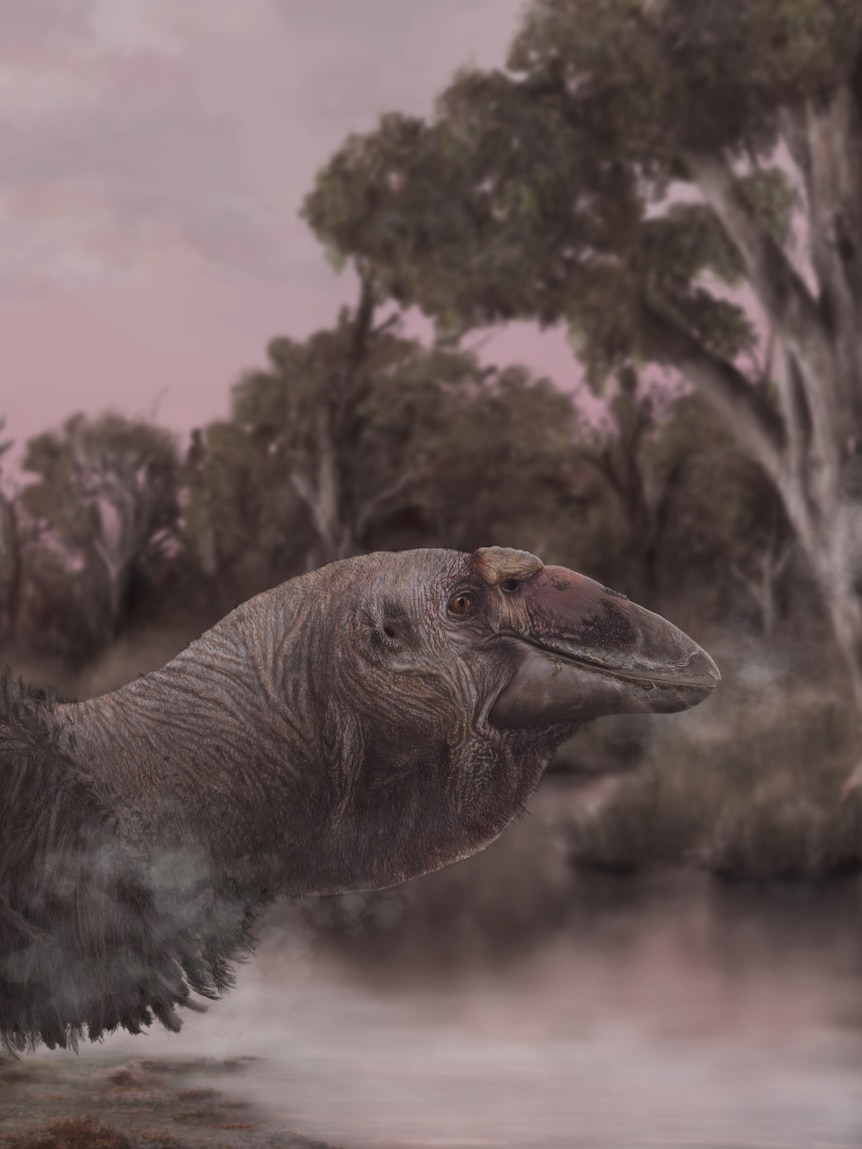Being chased by an irate goose can be a terrifying experience.
Now imagine a giant flightless version weighing almost a quarter of a tonne and standing as tall, if not taller than, basketball legend Michael Jordan.
This is what one of Australia’s long-dead species of Dromornithidae — a group of gigantic birds also known as mihirung — looked like, according to a study published in the journal Historical Biology.
The prehistoric bird in question, Genyornis newtoni, was first described in 1896, but our only understanding of what its head looked like came from a few broken bits of fossilised skull, discovered in 1913, which could not be reconstructed.
Early assumptions were its noggin may have looked similar to one of the other seven Dromornithidae species, or like that of an emu.
Then, in the late 1990s, palaeontologists suggested the extinct bird’s appearance was akin to that of land or waterfowl, earning it the nickname “demon duck”.
Now, a cache of six partial skull specimens has strengthened the theory G. newtoni shares commonalties with modern geese and the first water fowl — the South American southern screamer.
A beak through time
The new skull material was gathered between 2013 and 2019 from Pirlatapa and Adnyamathanha country at Lake Callabonna, around 600km north of Adelaide.
The fossil discovery means we now know a lot more about the biology of the prehistoric bird dubbed the “giga-goose,” according to Flinders University palaeontologist and study lead author Phoebe McInerney.
The bird was a bulky bush chook that would have stood about 2 metres or more, and hit around 230 kilograms on the bathroom scales.
“The beak itself is very goose-like, so we have this wide, flat, rounded end,” Dr McInerney said.
But Dr McInerney said bones and muscles on G. newtoni’s head shared many anatomical similarities with today’s southern screamers.
“They also interestingly have features that allow them to open and close their jaw underwater … without impacting their hearing or [water] going up into their palate or nose,” she said.
“Which is quite unusual because we weren’t expecting to see these water-based adaptions in the skull.”
The similarities with screamers has Dr McInerney and her co-authors suggesting mihirung should stop being considered a close relation to another group of prehistoric birds found in North America and Europe called Gastornithidae.
Instead the group should be placed on the evolutionary tree under the waterfowl order of birds, known as Anseriformes, within or near the South American screamer family Anhimidae.
Mihirung lived during the Ogliocene (33.9 to 23 million years ago) to about 45,000 years ago in the late Pleistocene when G. newtoni died out.
Dr McInerney says mihirung may have diverged from the screamer lineage about 66 million years ago when Australia, South America and Antarctica, which were part of the supercontinent Pangaea, started to break away from each other.
South Australian Museum and Flinders University evolutionary biologist Mike Lee, who was not involved in the study, said figuring out where exactly mihirung fit in evolutionary history had long been contentious.
“The new study shows that they share lots of skull details with the screamer ducks from South America,” he said.
“The exact ecology of mihirung is hard to infer.
“They lack obvious aquatic adaptations such as duck bills or paddling feet, but it remains possible they were closely associated with water.”
What happened to the ‘giga-goose’?
As far as we know, G.newtoni was the last of the mihirung to go extinct.
Because of crossover with people, who were in Australia about 65,000 years ago, there is a popular idea that egg consumption by First Nations people contributed to the big bird dying out.
Another theory has involved climate change and the drying of the central Australian landscape which is in an arid zone.
Dr McInerney said she thought a mixture of egg predation and disappearing wetland environments resulted in the end of the bird.
“I think this species was highly adapted to wetland environments and the edges of creeks and other really flourishing healthy areas where there’s lots of water,” she said.
“They probably would have gone extinct eventually if humans hadn’t arrived.”
Flinders University professor Trevor Worthy, who is another of the new study’s co-authors, said he thought that while G. newtoni might have liked to browse on plants near the water, its large mass and big legs meant it was not well adapted to soft ground.
“[It] is very much a bird of the arid zone, given so few bones found elsewhere, but doubtless it relied on the riparian habitats [banks of water bodies] along the major rivers and lakes,” he said.
The skulls haven’t given up all their secrets yet.
Dr McInerney said she planned to analyse G. newtoni‘s inner ear bones to figure out how the bird moved across the landscape.
“The inner ear is more related to locomotion and balance rather than hearing,” she said.
“We can make inferences about how they moved and how that changed as they grew giant.”
Get all the latest science stories from across the ABC.




